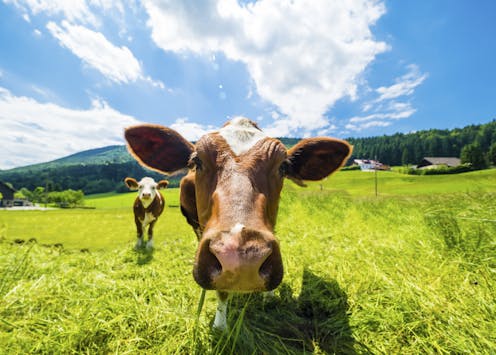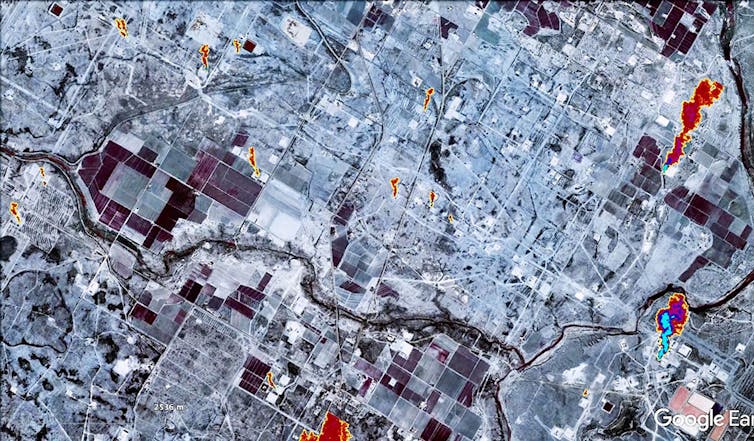New Zealand wants to tax cow burps – here's why that's not the best climate solution
New Zealand is considering a plan to tax methane from cows. But while cows and cars both emit greenhouse gases, they don’t have the same impact over time.

New Zealand, where agriculture is one of the largest contributors to climate change, is proposing a tax on cow burps. The reason seems simple enough: Cows release methane, a potent greenhouse gas, and New Zealand has a goal of reaching net-zero emissions by midcentury. Right now, the country’s effects on climate change come roughly equally from carbon dioxide and methane.
Worldwide, 150 governments have committed to cut methane emissions, both from agriculture and by cracking down on the largest source – fugitive leaks from natural gas pipelines and other fossil fuel infrastructure.
But is methane from cows really as bad for the climate as methane from fossil fuels? And given its shorter lifetime in the atmosphere, is methane as bad as carbon dioxide?
The answers involve renewable resources and the so-called circular economy. Understanding the effectiveness of different strategies is important as countries plan their routes to net-zero emissions, which is necessary for the world to stop further climate change.
Moreover, emissions must not just reach net-zero, they must stay there.
Targeting methane
I am a climate scientist who has spent decades studying global warming. Evidence has clearly established that human activities are causing climate change. Humans have released so much carbon dioxide into the atmosphere since beginning to burn fossil fuels in the 1800s that the accumulated gases are now trapping significantly more heat than is released to space. The result is global warming.
Some carbon dioxide stays in the atmosphere for hundreds to thousands of years. But methane, the second-most important greenhouse gas, lingers in the atmosphere for only about a decade before being oxidized to form carbon dioxide.
Although methane doesn’t last as long, it is many times more potent than carbon dioxide at warming the climate. That’s why it’s a target for policymakers.
However, its effects can be misjudged. A rough equivalence of the heating from methane to that of carbon dioxide is often used to estimate its effects on the climate, but the number varies by the time frame.
The global warming potential typically used for methane is 28 times that of carbon dioxide for a 100-year period. But a spike in methane has no effect after about 30 years because the methane is well gone by then. So, methane’s effects on temperature are greatly overstated over centuries, while considerably understated over the first 20 years. Indeed, scientists have argued that short-lived climate pollutants such as methane should be split out from long-lived ones such as carbon dioxide when making policy.
Moreover, biogenic sources of carbon, such as from trees or cattle, are renewable, while fossil fuel sources are not.
Biogenic or fossil?
Biogenic methane comes from all sorts of livestock – cattle, sheep, goats, deer and even buffalo – and it has a circular life.
It originates as carbon dioxide in the atmosphere that is taken up by grass and other plants during photosynthesis. Those plants are eaten by animals and then methane is burped out during digestion, or released as flatulence or through decaying manure. Once released, methane stays in the atmosphere for about a decade before it becomes carbon dioxide and is taken up by plants again.
Some carbon is temporarily stored as meat, leather or wool, but it too is eventually recycled. The amount of methane from livestock would be stable were it not for rising demand for animal protein by the ever-increasing global population, leading to increasing livestock on farms.
Fossil fuels, on the other hand, have been in the Earth for millions of years. Fossil methane is a waste product of coal mines, and also is extracted from shale and other underground deposits as natural gas. So-called fugitive emissions leak from pipelines and abandoned wells, and methane is often flared or vented directly into the atmosphere. There are also often major outbursts from accidents that can now be tracked from satellite. The Nord Stream gas leak in September 2022, likely caused by sabotage, reportedly leaked 500,000 tons of methane.

While biogenic methane ultimately recycles the carbon dioxide that was its source a short time ago, fossil-sourced methane adds carbon dioxide to the atmosphere. Studies have estimated that livestock is responsible for about one-third of global anthropogenic methane emissions, while oil and gas operations represent about 63%.
That doesn’t mean countries shouldn’t reduce biogenic methane, too. But the circular life of biogenic methane means that it should be considered separately from fossil methane when determining how to manage emissions to reach net zero by 2050.
Implications for climate policies
Many of the actions that governments take today under the guise of net-zero emissions risk passing the harms of climate change down to future generations rather than fundamentally solving the problem. Strategies that aim to reduce carbon from any source, as opposed to focusing on reducing the use of fossil fuels, are an example.
Right now, carbon dioxide from burning fossil fuels is generally treated interchangeably with carbon emissions from clearing forests or from methane emissions. Simple conversion factors, while convenient, mask complicated value judgments. For example, reducing methane may buy a decade of lower temperatures. Reducing fossil carbon, on the other hand, buys thousands of years.
There’s a similar argument to be made about carbon offsets involving trees. Trees take up carbon dioxide during photosynthesis and use the carbon to create wood, bark, leaves and roots. When the trees die or are used, the carbon is recycled as carbon dioxide. But while planting a new stand of trees may lock up some carbon, most only live for decades, and trees can get diseased or burn in forest fires, meaning they’re temporary. Recent research suggests that the value of trees as carbon offsets is greatly overestimated. Further, planting monoculture tree plantations has drawbacks, especially with regard to biodiversity.
Emissions from burning coal, oil or natural gas can only be credibly offset by removing carbon dioxide and storing it in a form that will be stable for many thousands of years.
Steadying or reducing livestock numbers and perhaps changing their feed can stabilize their methane emissions. But to address the climate change crisis long term, I believe it is essential to recognize that the real solution for climate change is to cut emissions of fossil fuels.
Kevin Trenberth does not work for, consult, own shares in or receive funding from any company or organization that would benefit from this article, and has disclosed no relevant affiliations beyond their academic appointment.
Read These Next
West Antarctica’s history of rapid melting foretells sudden shifts in continent’s ‘catastrophic’ geo
A picture of what West Antarctica looked like when its ice sheet melted in the past can offer insight…
People are getting their news from AI – and it’s altering their views
Even when information is factually accurate, how it’s presented can introduce subtle biases. As large…
Autocracies in transition: In 2025, Cameroon and Tanzania rulers clung to power — but look more vuln
The countries, whose respective leaders recently won widely disputed elections, offer contrasting examples…






